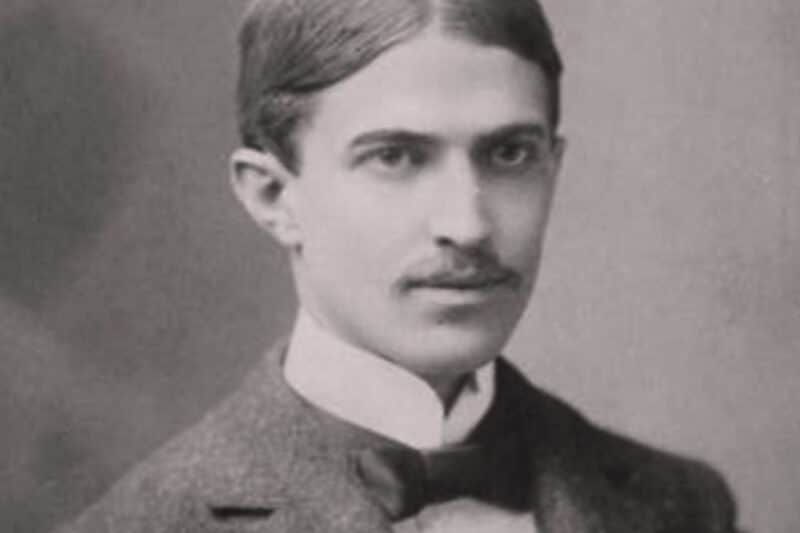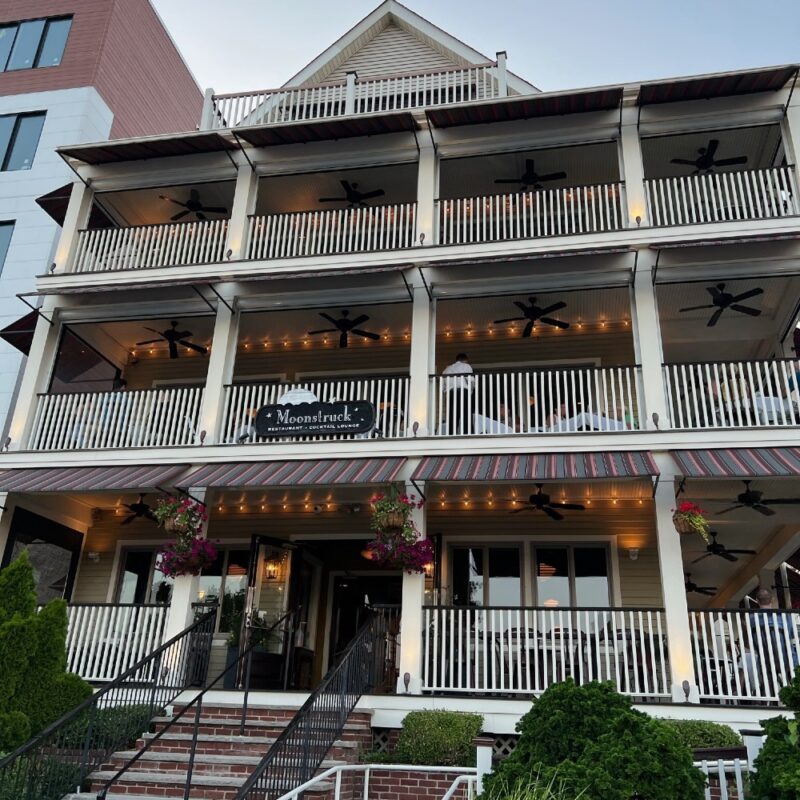Before Stephen Crane became canonized in American Literature, he worked as a lowly newspaper reporter in Asbury Park collecting ghost stories. Two years after leaving Asbury Park for New York City, he could not stop thinking about the weird tales from the Jersey Shore, and in 1894 he compiled them in a New York Press publication recounting the haunts of a Wicked Tory Captain, a phantom Native American, and a spectral Black Hound. His interest in the supernatural not only lasted throughout his lifetime but may have extended beyond his life too—for it is said he haunts the very Asbury Park building in which he used to live. Read on to learn more about Stephen Crane’s Ghost Stories and the Story of Stephen Crane’s Ghost.
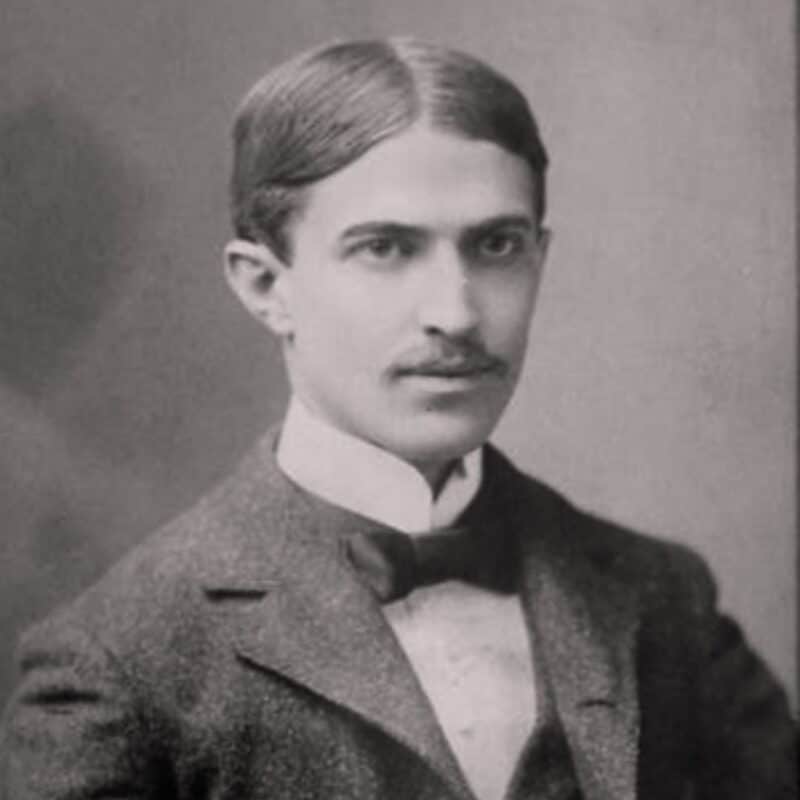
Photo Credit: Public Domain
In fact, it can truly be said that more hair has risen on the New Jersey shore than at any other place of the same geographical dimensions in the world. – Stephen Crane
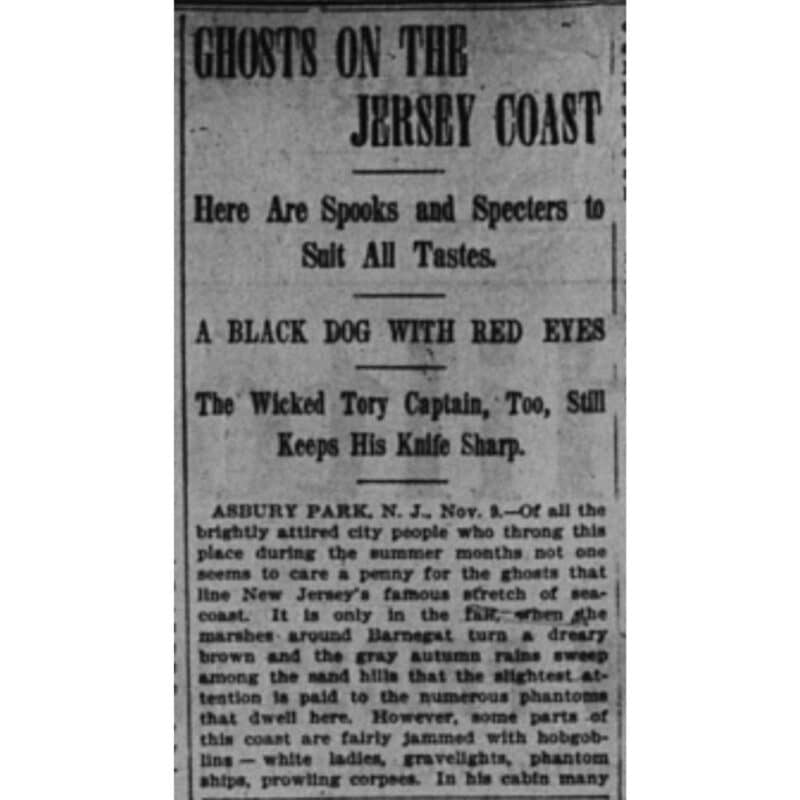
Photo Credit: Tulane University Special Collections
One year before Stephen Crane broke it big with The Red Badge of Courage (1895), he collected a series of ghost stories for the New York Press (a periodical that later became the more famed newspaper: The Sun).
He’d written for the Asbury Park Tribune, before his wry and sarcastic coverage of an “American Day Parade” had him unceremoniously dismissed in September of 1892. However, that did not stop Stephen from writing about the Jersey Shore.
He took up a position at the New York Press and collected a series of Jersey Shore ghost stories, publishing them in November of 1894, proclaiming: some parts of this coast are fairly jammed with hobgoblins — white ladies, grave lights, phantom ships, [and] prowling corpses.
Read More: The History Behind Oscar Wilde’s Trip to the Jersey Shore
Branchburg
Stephen begins his ghostly tour in Branchburg where locals reported seeing will-o’-the-wisp — an atmospheric, ghostly light witnessed at night, especially over bogs, swamps, or marshes.

Photo Credit: Public Domain
Attributed to fairies, ghosts, or spirits, is said will-o’-the-wisps mislead travelers by resembling lamps or lanterns. Stephen warns:
[In] Branchburg, too, there are people who will pummel your features well if you deny the dim bluish light that floats above the long grave wherein lie the dead…flickering and spluttering in spectral wrath whenever any attempt is made after the gold which is said to have been buried with the bodies of the unfortunate sailors and emigrants.
Deal Beach

Deal Beach has its share of ghosts too, albeit of a more romantic variety. Stephen avows that late at night, you may catch a glimpse of two young lovers whose fate is unknown, but whose love is enduring:
At Deal Beach a youth and a maiden, impalpable as sea mist, perambulate to and fro on the bluff, keeping their lovers’ tryst while the wind swirls in the branches of the solitary tree and the stars shine through their forms of air.
Shark River
At Shark River, Stephen warns you may glimpse the sails of a horrific pirate ship cruising the waters in search of its next victim, a ship that makes Captain Jack Sparrow’s Black Pearl look like a child’s toy:
[I]f you go into the huckleberry region back of Shark River you had better not scorn the story of the great pirate ship that sails without trouble in twelve inches of water and has skeletons dangling at the mastheads. Terrible faces peer over the bulwarks, and confound the visions of any who would witness the phantom movements from the shore.
According to Stephen, Shark River is also haunted by a phantom Native American “who stalks through the land at night…looking for his fair young bride.”
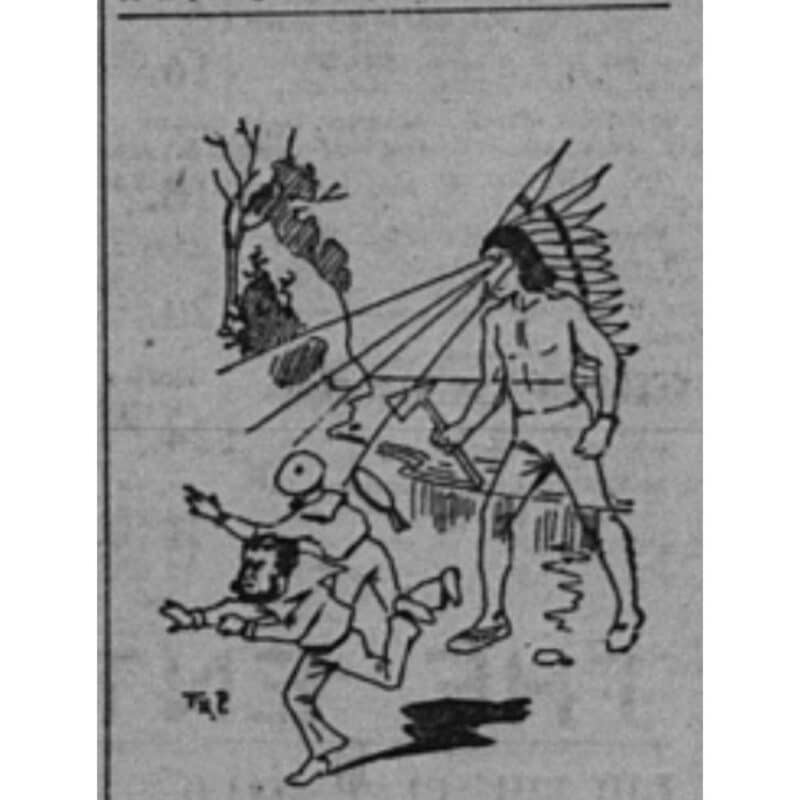
Photo Credit: Tulane University Special Collections
Once, a gang of young men inebriated on “applejack,” drank up the courage to confront the Native American spirit, but when they neared, the ghost turned, staring at them with a beaming gaze, a “stiletto-like glance…which went straight through them as if they had been made of paper,” and the men ran away as fast as their shaking legs could carry them.
Barnegat
Stephen’s ghostly tour continues further south, in Barnegat, where a witch’s hideous laugh skims the water and echoes throughout the marshes:
[I]n the little villages of the fishermen south of here, near the salt marshes of Barnegat, a man had better think three times before he openly scorns the legends of the phantoms.
Near Barnegat Light, wicked fishermen engaged in doing that which they ought not to do, hear eerie chuckles, and upon looking up quickly see an old crone, who chuckles at them for a moment and then goes off, looking back occasionally to chuckle.
Long Beach
Stephen records a tale at Long Beach where blood from the American Revolution still stirs restless souls — for a knife-wielding Tory seeks blood from the throats of new victims. Fearfully fleeing fishermen report invisible, yet pursuing footsteps upon the sand which chase them until they reach the safety of their home:
At Long Beach, where men deep in slumber were killed by brave Refugees and Tories from New York, few fishermen care to lie and sleep, for then the gray specter of the Tory captain, hideous from the ancient crimes, comes and holds a knife at the throat. When they flee they hear feet crunch in the sand at their heels, and no matter how fast they run they cannot shake off this invisible pursuer, who follows them to their threshold.
Asbury Park
Stephen’s affinity for the supernatural may have extended beyond his own life: it is rumored that his spirit still haunts the Asbury Park home in which he’d resided.

Built in 1878, Stephen (or “Stevie” as his mother called him) was raised in this Asbury Park home located at 508 4th Avenue. Here, Stephen composed his earliest stories and first penned newspaper articles for his older brother’s Asbury Park newspaper.
Stephen sold his share of the house to finance the publication of his first novel, Maggie, A Girl of the Streets (1893), and he never returned during his lifetime—but has that stopped his ghost? The Crane family finally sold the house in 1899, and since then the building has been occupied by squatters, hotel guests, the Asbury Park Historical Society, and perhaps something else?
In the 130 years since Stephen’s departure from the house, the building has reported a slew of ghostly encounters.
Visitors commonly experience a creepy feeling throughout the house and a prevailing sense of an unexplainable presence. From the outside, by-passers swear they’ve seen a woman in the attic window. Such supernatural encounters are not limited to visitors but are also reported by residents.
Chris Hayes (the son of a former homeowner) was celebrating his older brother’s birthday party when he heard a sudden clank and a fireplace shovel inexplicably fell and struck him on the forehead.
A tenant living upstairs on the second floor awoke startled one night when she found a heavy-set gentleman standing within the doorway of her room. He sported sideburns, and Victorian garb, and took one step into the room before turning and proceeding down the hallway.
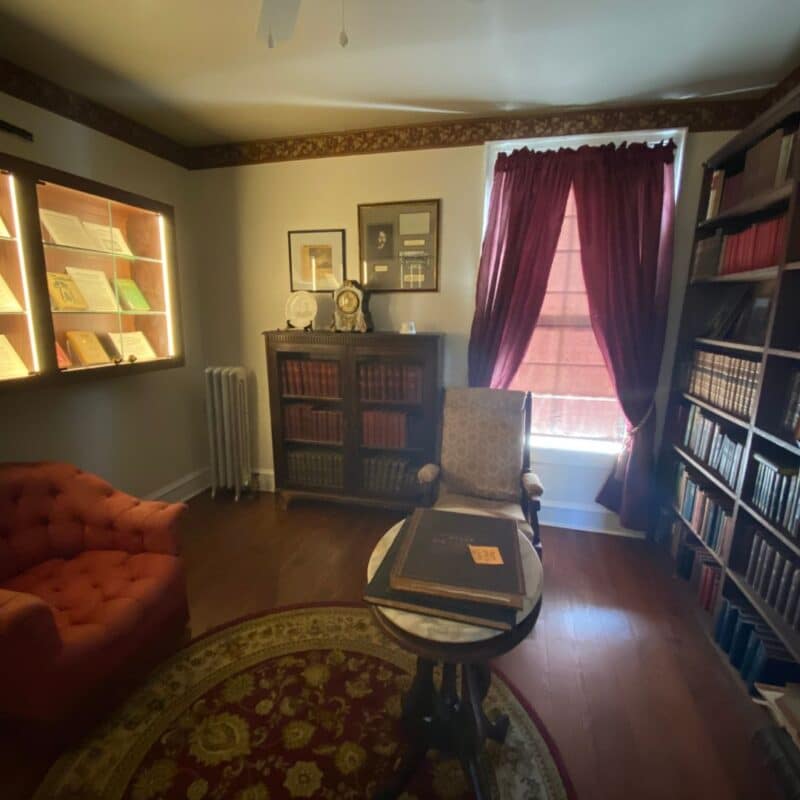
Another time, when the entire house was empty but for two residents, one heard footsteps accompanied by a woman saying “Hello?” When the resident turned, no one was there. In the following room, the second occupant felt an extreme temperature drop out of nowhere.
More generally, people claim firmly latched doors mysteriously open, fire pokers move, while audible sounds of crying and the peculiar din of children playing can be heard at all hours of the night.
The house has been investigated by paranormal researchers and even appeared on a 2010 episode of the SyFy Channel’s “Ghost Hunters” (Season 6, Episode 4). During the filming, doors opened and closed without explanation, and the filming team captured the mystifying audio of a disembodied voice.
Might these sounds be attributed to the specter of Stephen Crane, or perhaps other ghostly occupants?
Bonus: Full Ghost Story
In Stephen’s 1894 collection of Ghosts on the Jersey Coast, he closes with the Tale of the Black Dog. This story has become so obscured by the cobwebs of time that finding it in a printed publication or on the internet proves futile. Therefore, to close, The Asbury Girl would like to republish Stephen Crane’s story in his own words for the first time in nearly 130 years.
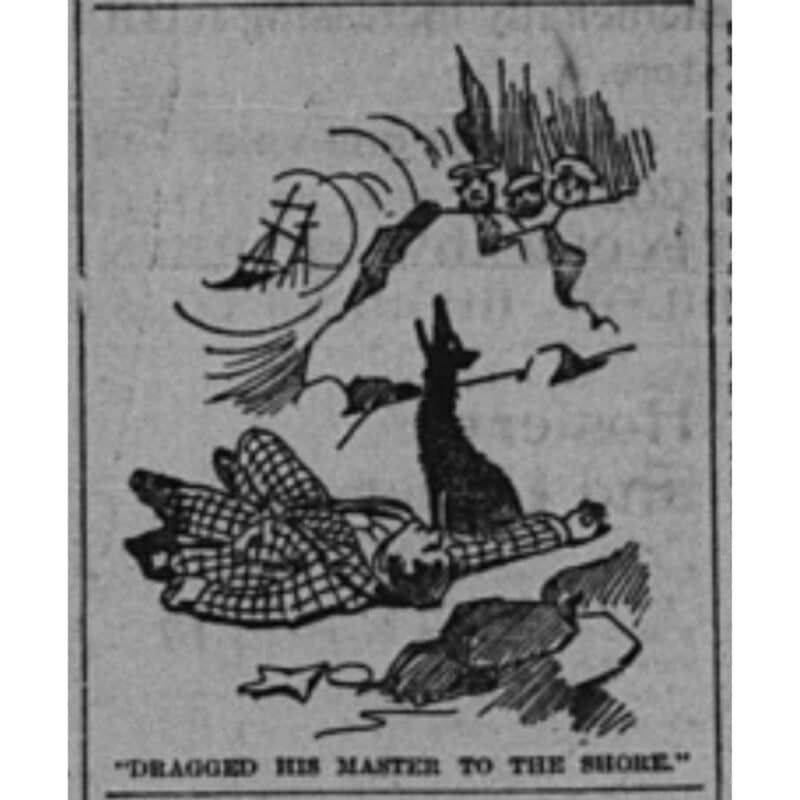
Photo Credit: Tulane University Special Collections
See More: Mermaids in New Jersey: A Full Breakdown
The Tale of the Black Dog
(NOTE: this is not the popularly reproduced story “The Black Dog” which was published by The New York Tribune on July 24, 1892. That story has a tidy, neat, explainable ending and is a parody of a ghost story. This “Tale of the Black Dog” was published two years later and remains faithful to supernatural lore.)
The tradition of the black dog has been much obscured because of its great age. It relates away back prior to the Revolution, when the New Jersey coast was for the most part unpeopled. It was a desolate stretch of sand, pine forest, and salt marsh. Upon the narrow strip of land that separates Barnegat Bay from the ocean there then lived men who were so villainous that they had made a business of luring ships to the shore by means of false lights, that in stormy weather shone afar out to the jaded sailors, precisely as bright as the brightest beacon of hope. When the vessel would be wrecked, the pirates gayly plundered it. It was their habit to murder the crews.
One night there came a great storm which tossed the vessels upon the sea like little chips. The Jersey coast was strewn with wreckage and many strong ships lay dying upon the bar. No coast had proved so formidable to navigation as the New Jersey shore, just a brown lip of land rearing from the sea. From a vessel, the coast looks so low that one wonders why each wave has not swallowed it.
During this storm, a fine full rigged ship struck the bar directly opposite the stronghold of the band of pirates. They ran down to the beach and cheered and caroused, for they had not even been put to the trouble of deceiving the pilot and decoying the ship upon the bar. The thing had happened without labor or plan. They gathered in a crowd at the edge of the surf and watched the ship’s people clinging to the rigging and looking toward the shore. They clung in bunches, lines, and irregular groups, reminding one of some kind of insect. Sometimes a monstrous white wave would thunder over the ship, bearing off perhaps two or three sailors whose grasp it had torn away and tumbling the bones into the wide swirl of foam that covered the sea. Soon they grew so weary that they began to drop off one by one into the water, unable to stand the strain of the terrible rushes of the waves. The pirates on the shore laughed when they saw a mass of men try to launch the boats, for they knew that none could live in that sea. Presently, the bodies of the sailors and passengers began to wash up at the feet of the pirates, who searched them for jewels and money. The hull of the ship was hidden in the white smothering riot of water, but the rigging, with its lessening burden of men, was faintly outlined upon the dead black sky. The pirates became busily engaged in overhauling the corpses.
ENTER THE HOUND.
At last, a fine blackhound emerged slowly from the water and crawled painfully up the beach. He was dragging the body of a young man by the shirt collar. The dog had fought a tremendous battle. It seemed incredible that he could have forced his way to shore with the body through the wild surf. The young man’s face was ghastly in death. There was a grievous red wound in his temple where, perhaps, he had been flung against some wreckage by the wave. The dog hauled the body out of the reach of the water and then went to whine and sniff at the dead man’s hand. He wagged his tail expectantly. At last, he settled, shivering, back upon his haunches and gave vent to a long howl, a dog’s cry of death and despair and fear, that cry that is in the most indescribable key of woe. It made the pirates turn their heads instantly startled. They gathered about the dead body and the dog to stare curiously. At the approach of this band of assassins, vagabonds, and outcasts the hound braced himself, the hair on his neck ruffled and his teeth gleaming. For a moment they confronted each other, the pirates and the dog, guardian of his master’s corpse. There stood the dog, a tempest of water behind him, and the evil crowd of men before him, and not even a caress possible from the pallid hand at his feet. No doubt he did not comprehend the odds of his battle. He only knew one thing—to be faithful until he was dead.
Then one particularly precious villain perceived the glitter of gems upon the dead man’s hand. He reached covetously forward, and the dog lunged for his throat. An instant later there were many curses and the thud of blows and then, suddenly, a human-like scream from the dog. He crawled until he could lay his head upon the dead man’s chest, and there he died, as the robbers were pulling the rings from his master’s fingers.
The phantom of this blackhound is what the fishermen see as they return home from their boats and nets late at night. There is a dreadful hatchet wound in the animal’s head, and from it, the phantom blood bubbles, his jaws drip angry foam, and his eyes are lit with a crimson fire. He gallops continuously with his nose to the ground as if he were trailing someone. If you are ever down upon the New Jersey coast at midnight and meet this specter, you had better run.
Special thanks to Dr. Agnieszka Czeblakow, Curator of Rare Books + Head of Research Services at Tulane University Special Collections for providing a copy of “Ghosts on the Jersey Coast,” and to Joshua Windham for locating the article upon microfiche.
Special thanks to Susan Rosenberg, the Stephen Crane House board member and docent who offers tours of the Stephen Crane House each Sunday from 12PM – 2PM, or by appointment (732.361.0189).


